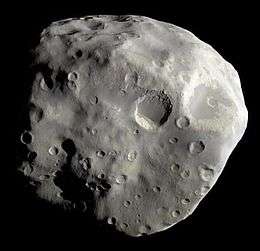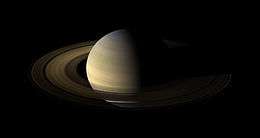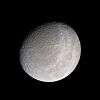Epimetheus (moon)
|
As imaged by Cassini on December 3, 2007 | |
| Discovery | |
|---|---|
| Discovered by | Richard Walker |
| Discovery date | December 18, 1966 |
| Designations | |
| Pronunciation | /ɛpᵻˈmiːθiəs/ ep-i-MEE-thee-əs |
| Adjectives | Epimethean |
| Orbital characteristics [1] | |
| Epoch 31 December 2003 (JD 2453005.5) | |
| 151410±10 km | |
| Eccentricity | 0.0098 |
| 0.694333517 d | |
| Inclination | 0.351°±0.004° to Saturn's equator |
| Satellite of | Saturn |
| Physical characteristics | |
| Dimensions | 129.8 × 114 × 106.2 km [2] |
Mean radius | 58.1±1.8 km [2] |
| Volume | ≈ 780000 km3 |
| Mass | (5.266±0.006)×1017 kg [2] |
Mean density | 0.640±0.062 g/cm³ [2] |
| 0.0064–0.011 m/s² [2] | |
| ≈ 0.035 km/s | |
| synchronous | |
| zero | |
| Albedo | 0.73±0.03 (geometric) [3] |
| Temperature | ≈ 78 K |
|
| |
Epimetheus is an inner satellite of Saturn. It is also known as Saturn XI. It is named after the mythological Epimetheus, brother of Prometheus.
Discovery
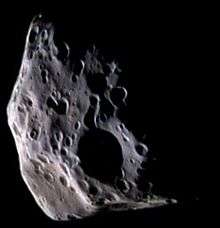
Epimetheus occupies essentially the same orbit as the moon Janus. Astronomers assumed that there was only one body in that orbit, and accordingly had difficulty determining their orbital characteristics. Observations were photographic and spaced widely apart in time, so that while the presence of two objects was not obvious, the observations were difficult to reconcile with a reasonable orbit.
Audouin Dollfus observed a moon on December 15, 1966,[4] which he proposed to be named "Janus".[5] On December 18, Richard Walker made a similar observation which is now credited as the discovery of Epimetheus.[6] However, at the time, it was believed that there was only one moon, unofficially known as "Janus", in the given orbit.
Twelve years later, in October 1978, Stephen M. Larson and John W. Fountain realised that the 1966 observations were best explained by two distinct objects (Janus and Epimetheus) sharing very similar orbits.[7] This was confirmed in 1980 by Voyager 1,[8] and so Larson and Fountain officially share the discovery of Epimetheus with Walker.
Epimetheus received its name in 1983.[lower-alpha 1] The name Janus was approved by the IAU at the same time, although the name had been used informally since Dollfus proposed it shortly after the 1966 discovery.
Orbit
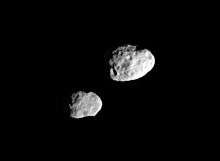

Epimetheus's orbit is co-orbital with that of Janus. Janus's mean orbital radius from Saturn is, as of 2006 (as shown by green color in the adjacent picture), only 50 km less than that of Epimetheus, a distance smaller than either moon's mean radius. In accordance with Kepler's laws of planetary motion, the closer orbit is completed more quickly. Because of the small difference it is completed in only about 30 seconds less. Each day, the inner moon is an additional 0.25° farther around Saturn than the outer moon. As the inner moon catches up to the outer moon, their mutual gravitational attraction increases the inner moon's momentum and decreases that of the outer moon. This added momentum means that the inner moon's distance from Saturn and orbital period are increased, and the outer moon's are decreased. The timing and magnitude of the momentum exchange is such that the moons effectively swap orbits, never approaching closer than about 10,000 km. At each encounter Janus's orbital radius changes by ~20 km and Epimetheus's by ~80 km: Janus's orbit is less affected because it is four times more massive than Epimetheus. The exchange takes place close to every four years; the last close approaches occurred in January 2006,[9] 2010 and 2014, and the next in 2018. This is the only such orbital configuration known in the Solar System.[10]
The orbital relationship between Janus and Epimetheus can be understood in terms of the circular restricted three-body problem, as a case in which the two moons (the third body being Saturn) are similar in size to each other.
Physical characteristics
There are several Epimethean craters larger than 30 km in diameter, as well as both large and small ridges and grooves. The extensive cratering indicates that Epimetheus must be quite old. Janus and Epimetheus may have formed from a disruption of a single parent to form co-orbital satellites, but if this is the case the disruption must have happened early in the history of the satellite system. From its very low density and relatively high albedo, it seems likely that Epimetheus is a very porous icy body. There is a lot of uncertainty in these values, however, and so this remains to be confirmed.
The south pole shows what might be the remains of a large impact crater covering most of this face of the moon, and which could be responsible for the somewhat flattened shape of the southern part of Epimetheus.
There appear to be two terrain types: darker, smoother areas, and brighter, slightly more yellowish, fractured terrain. One interpretation is that the darker material evidently moves down slopes, and probably has a lower ice content than the brighter material, which appears more like "bedrock". Nonetheless, materials in both terrains are likely to be rich in water ice.[11]
Ring
A faint dust ring is present around the region occupied by the orbits of Epimetheus and Janus, as revealed by images taken in forward-scattered light by the Cassini spacecraft in 2006. The ring has a radial extent of about 5000 km.[12] Its source are particles blasted off their surfaces by meteoroid impacts, which then form a diffuse ring around their orbital paths.[13][14]
Gallery

 Epimetheus - flyby
Epimetheus - flyby
(December 6, 2015)
See also
References
Notes
- ↑ Transactions of the International Astronomical Union, Vol. XVIIIA, 1982 (confirms Janus, names Epimetheus, Telesto, Calypso) (mentioned in IAUC 3872: Satellites of Jupiter and Saturn 1983 September 30)
Citations
- ↑ Spitale Jacobson et al. 2006.
- 1 2 3 4 5 Thomas 2010.
- ↑ Verbiscer French et al. 2007.
- ↑ IAUC 1987.
- ↑ IAUC 1995.
- ↑ IAUC 1991.
- ↑ Fountain & Larson 1978.
- ↑ Leverington 2003, p. 454.
- ↑ JPL/NASA: The Dancing Moons.
- ↑ El Moutamid et al 2015.
- ↑ JPL/NASA: Epimetheus Revealed.
- ↑ JPL/NASA: Moon-Made Rings.
- ↑ Williams et al. 2011.
- ↑ JPL/NASA: Creating New Rings.
Sources
- El Moutamid, M.; et al. (1 October 2015). "How Janus' Orbital Swap Affects the Edge of Saturn's A Ring?". arXiv:1510.00434
 .
. - Fountain, J. W.; Larson, S. M. (1978). "Saturn's ring and nearby faint satellites". Icarus. 36: 92–106. Bibcode:1978Icar...36...92F. doi:10.1016/0019-1035(78)90076-3.
- Gingerich, Owen (January 3, 1967). "Probable New Satellite of Saturn" (discovery). IAU Circular. 1987. Retrieved 2011-12-28.
- Gingerich, Owen (January 6, 1967). "Possible New Satellite of Saturn". IAU Circular. 1991. Retrieved 2011-12-28.
- Gingerich, Owen (February 1, 1967). "Saturn X (Janus)" (naming Janus). IAU Circular. 1995. Retrieved 2011-12-28.
- "PIA08328: Moon-Made Rings". Photojournal. JPL/NASA. 2006-10-11. Retrieved 2011-12-29.
- "PIA09813: Epimetheus Revealed". Photojournal. JPL/NASA. 2008-01-11. Retrieved 2011-12-29.
- "The Dancing Moons". Cassini Solstice Mission. JPL/NASA. May 3, 2006. Retrieved 2011-12-29.
- "NASA Finds Saturn's Moons May Be Creating New Rings". Cassini Solstice Mission. JPL/NASA. October 11, 2006. Retrieved 2011-12-29.
- Leverington, David (2003). Babylon to Voyager and beyond: a history of planetary astronomy. Cambridge University Press. ISBN 0-521-80840-5.
- Marsden, Brian G. (September 30, 1983). "Satellites of Jupiter and Saturn". IAU Circular. 3872. Retrieved 2011-12-23.
- Spitale, J. N.; Jacobson, R. A.; Porco, C. C.; Owen, W. M., Jr. (2006). "The orbits of Saturn's small satellites derived from combined historic and Cassini imaging observations" (PDF). The Astronomical Journal. 132 (2): 692–710. Bibcode:2006AJ....132..692S. doi:10.1086/505206.
- Thomas, P. C. (July 2010). "Sizes, shapes, and derived properties of the saturnian satellites after the Cassini nominal mission" (PDF). Icarus. 208 (1): 395–401. Bibcode:2010Icar..208..395T. doi:10.1016/j.icarus.2010.01.025.
- Verbiscer, A.; French, R.; Showalter, M.; Helfenstein, P. (9 February 2007). "Enceladus: Cosmic Graffiti Artist Caught in the Act". Science. 315 (5813): 815. Bibcode:2007Sci...315..815V. doi:10.1126/science.1134681. PMID 17289992. Retrieved 20 December 2011. (supporting online material, table S1)
- Williams, G.A.; Murray, C.D. (March 2011). "Stability of co-orbital ring material with applications to the Janus-Epimetheus system". Icarus. 212 (1): 275. Bibcode:2011Icar..212..275W. doi:10.1016/j.icarus.2010.11.038.
External links
![]() Media related to Epimetheus (moon) at Wikimedia Commons
Media related to Epimetheus (moon) at Wikimedia Commons
- Epimetheus Profile by NASA's Solar System Exploration
- The Planetary Society: Epimetheus
- Cassini Images of Epimetheus
- 'Solar System Dynamics' by Murray and Dermott The standard text on the subject, describes the orbits in detail.
- QuickTime animation of co-orbital motion from Murray and Dermott
- Cassini image of Janus and Epimetheus near the time of their orbital swap.
- Epimetheus nomenclature from the USGS planetary nomenclature page
